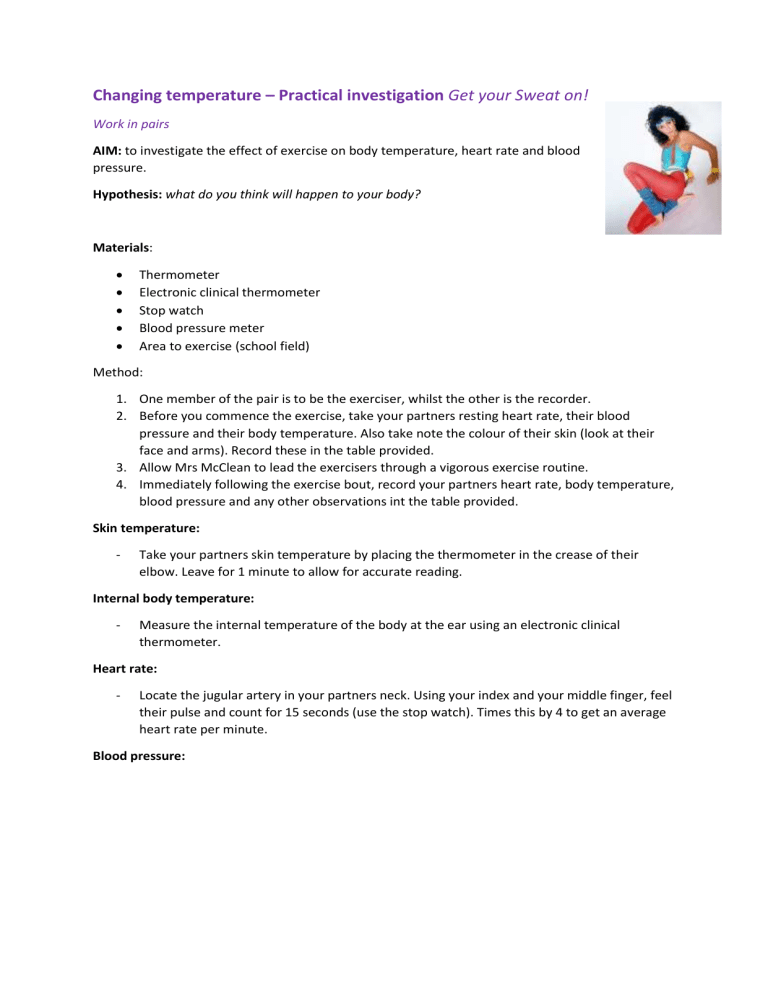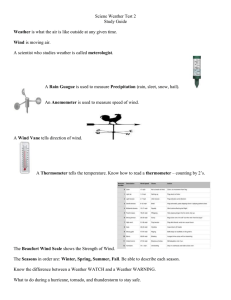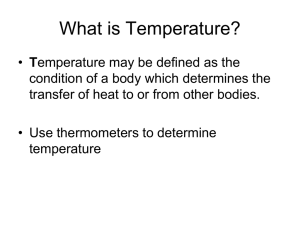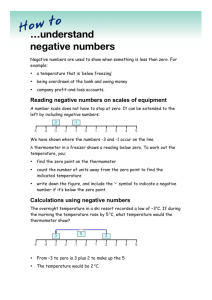
Changing temperature – Practical investigation Get your Sweat on! Work in pairs AIM: to investigate the effect of exercise on body temperature, heart rate and blood pressure. Hypothesis: what do you think will happen to your body? Materials: Thermometer Electronic clinical thermometer Stop watch Blood pressure meter Area to exercise (school field) Method: 1. One member of the pair is to be the exerciser, whilst the other is the recorder. 2. Before you commence the exercise, take your partners resting heart rate, their blood pressure and their body temperature. Also take note the colour of their skin (look at their face and arms). Record these in the table provided. 3. Allow Mrs McClean to lead the exercisers through a vigorous exercise routine. 4. Immediately following the exercise bout, record your partners heart rate, body temperature, blood pressure and any other observations int the table provided. Skin temperature: - Take your partners skin temperature by placing the thermometer in the crease of their elbow. Leave for 1 minute to allow for accurate reading. Internal body temperature: - Measure the internal temperature of the body at the ear using an electronic clinical thermometer. Heart rate: - Locate the jugular artery in your partners neck. Using your index and your middle finger, feel their pulse and count for 15 seconds (use the stop watch). Times this by 4 to get an average heart rate per minute. Blood pressure: Results: Time Heart rate (bpm) Blood pressure mm Hg Body temperature Degree C Skin colour/appearance (red, pale, clamy, dry, sweaty) Pre exercise Immediately after exercise 10 minutes post exercise Observations: Graph the results for body temperature using a line graph Discussion questions: 1. What did you notice about your breathing rate, during and after exercise? What do you think caused this? 2. Describe the skin temperature changes as a result of the exercise. 3. Describe the skin temperature change after 10 minutes resting. 4. Compare your 10 minute post exercise observations with your pre exercise observations. 5. Extension: How is this an example of homeostasis and negative feedback control? 6. What do you think would occur if your body didn’t “turn off” its cooling down protocol? Practical investigation background information. Exercise and Heart rate: When you exercise your body requires more oxygen and nutrients to your muscles in order to work at a higher capacity. This results in requiring more blood to the area to provide the oxygen. Your body responds by dilating its blood vessels to those muscles, allowing more blood to flow to the area. Your body also increases your heart rate, so more blood is pumped around your body in a given time. The waste products produced during respiration are also picked up by the blood and cleared from the area. Carbon dioxide is breathed out, and waste products are metabolised in the liver. Temperature and exercise: As you exercise you are burning glucose as energy to fuel your muscles. Heat is a by-product of this. Heat is also produced during exercise as a result of friction. To remove excess heat during/post exercise your body does a few things. Blood is directed to the skin to expel heat. You sweat, relying on evaporation of the sweat from the skin to cool you down. Your breath rate increases to expel excess heat through your breath.




